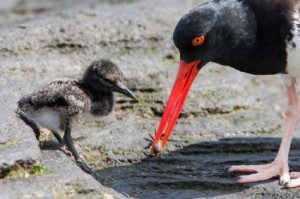
- An American Oystercatcher plucks a Moles Crab out of the sand.
Allow me to introduce to you the American Oystercatcher! The long, vibrant reddish-orange beak and yellow, red-ringed eyes of this large, otherwise neutrally colored, shorebird are so striking it is hard to pass this beauty by without taking a second look. As an easily identifiable bird, the American Oystercatcher is a great place to start when learning about shorebirds.

- American Oystercatcher
Common Name: American Oystercatcher
Latin Name: Haematopus palliatus
Range: Atlantic coast of North America, Gulf Coast and northern South America. Pacific coasts of Mexico, Central America and northern South America.
Habitat: Coastal areas, including beaches, marshes, dunes, and mudflats.
Diet: As its name suggests, the American Oystercatcher feeds on oysters and other bivalves and invertebrates. These include mussels, clams, starfish, limpets, jellyfish, etc.
Conservation Status: Although generally considered of least concern, the American Oystercatcher is listed as bird of special concern in many coastal states on account of habitat loss and vulnerability issues. We are reminded to enjoy these gorgeous shorebirds from afar in order to avoid disturbing them.

- American Oystercatcher (Haematopus palliatus galapagensis), Galapagos subspecies parent feeding a small crab to a downy chick on Santiago Island, Galapagos.
Three cool facts about this brightly billed bird!
- To disguise its speckled eggs, the adults add broken shells or pebbles to the nest and will sometimes pretend to roost where there is no nest in order to detour predators from actual nesting sites.
- A group of oystercatchers are collectively known as a “parcel” of oystercatchers.
- Breeding pairs may last for life.












